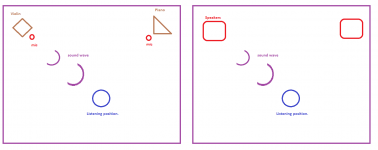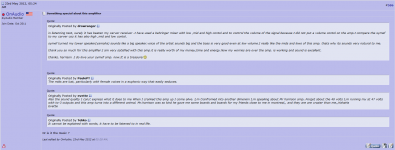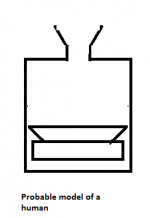Polar response and SPL, well.......I guess this is one of the ways one can model an instrument that is supposed to mimic all others assuming a flawless mic pickup and recording 😉
http://www.browsewallpapers.com/files/x-men-mystique-face-x-men-2810.jpg
http://www.browsewallpapers.com/files/x-men-mystique-face-x-men-2810.jpg
Last edited:
Meanwhile, many complain that you need to preserve pulse waveforms perfectly. You can't do that with anything other than acoustic first order. Well many people do first order, or "no-crossover" (cap for tweeter only) designs and think they are getting acoustic first order. And they usually aren't getting anything like that anyway. If you rely on speaker rolloff, you will typically get something faster than first order rolloff.
There is no filter order which allows you to preserve pulse waveforms or square waves perfectly, for the simple reason that they all introduce a 90 degree phase shift per filter order. The only way to accomplish it is to use an all pass filter that corrects for this phase shift. However, it is not worth the bother.
@ Palas' remark -quo - To narrow that down a bit, at least in the midrange I would say that the "magic crossover frequency" is where the directivity of the mid matches that of the tweeter. -unquo
That is imo exactly how it is, and the reason is self evident. If the directivity of the drivers around xover is different, you can only create a flat FR at one specific angle from the speaker.
vac
would you tell the difference in a dark room ? 😀
Depends on the room, the speaker and the recording. But then again, what might work for a particular speaker/room/recording system isn't applicable to the broad range of possible aural spaces we might like to reproduce.
Do instruments normally sound like they are coming from your speakers?would you tell the difference in a dark room ? 😀
You might want to revise that belief - an ideal 1st order crossover does in fact sum to exactly the same waveform as the original signal - in other words its transient perfect, introduces no phase shift, and reproduces square waves perfectly. It's the only type of analog/causal filter that does, and its very easy to prove that it does in a spice or filter simulator program.There is no filter order which allows you to preserve pulse waveforms or square waves perfectly, for the simple reason that they all introduce a 90 degree phase shift per filter order.
Of course the drivers themselves have limited bandwidths which will degrade square wave response, but that is unavoidable and unrelated to the crossover function. A 1st order filter is also far from ideal for other reasons such as wide overlap region with lots of lobing, poor out of band attenuation etc...making it not very practical in a but a very few cases.
An additional causal all pass filter can't subtract the excess phase added by the all pass function that is caused by the summing of the two crossover sections, it can only add yet more excess phase and further degrade square wave response.The only way to accomplish it is to use an all pass filter that corrects for this phase shift. However, it is not worth the bother.
The only way to correct for excess phase and get back to a minimum phase response is to use a non-causal digital filter, but any such non-causal filter is then going to introduce pre-ringing in the time domain, (since its "looking into the future" when calculating the result in each time interval) so is still not transient perfect.
Of course for any of this to matter you'd have to prove that being able to reproduce square waves without phase shift is actually important and audible in the first place, and that's far from proven, and generally considered to not be the case.
While that's true, you'd also have to prove that small dips in the frequency response in the wide off axis response of a speaker at high frequencies is actually audible. The belief that it is is almost taken as gospel by a lot of people but the research says otherwise. Absolute flatness of response at wide off axis angles is not nearly as important as often believed.That is imo exactly how it is, and the reason is self evident. If the directivity of the drivers around xover is different, you can only create a flat FR at one specific angle from the speaker.
Last edited:
Do instruments normally sound like they are coming from your speakers?
rephrase....😀
markus hits it exactly. The answer is simple. Whatever works! Every case is different. Instead of looking for some magical formula, get into your lab and get busy! I am only blabbering here as I wait for my M-Audio box. I removed my e-mu from service do to their inability to get it to even play a CD without crashing. (memory leak in driver they don't know how to fix) So I wait for my new 610, and wait for my SR-71 kit to do direct tweeter comparisons, metal to soft. I am trying to verify if it is the metal breakup that is causing the painful distortion my wife hears, or if I am wrong again. Besides, I want to hear what another respected designer thinks is a pretty good crossover to see how it compares to mine. I would have crossed over higher with a steeper electrical network.
I also have to agree with Simon. I would like to add one of the things about our brains is they adjust to irregularities as a signature of the environment. As long as you are within what we can "fix" in out heads, you do just fine. Spikes in response are far more audible in my experience.
Allen
I have been fooled only once. It was a half track master recording of a single upright bass. The system was Levinson and B&W from a Revox deck. If you closed your eyes, you could believe. This was in about 1985. No system has matched it since. The source material had a lot to do with it. Every speaker I have made or heard since sounded like speakers. Some very good, but they still sound like speakers.
I also have to agree with Simon. I would like to add one of the things about our brains is they adjust to irregularities as a signature of the environment. As long as you are within what we can "fix" in out heads, you do just fine. Spikes in response are far more audible in my experience.
Allen
I have been fooled only once. It was a half track master recording of a single upright bass. The system was Levinson and B&W from a Revox deck. If you closed your eyes, you could believe. This was in about 1985. No system has matched it since. The source material had a lot to do with it. Every speaker I have made or heard since sounded like speakers. Some very good, but they still sound like speakers.
tvrgeek, the perfect speaker should have a supressed personal identity, it takes on the shape of whatever it is supposed to be. If you need it to turn into a little dog and bark like a little dog. It should.
If you need it to turn into a lion and roar like one it should. If you need it to bring beautiful ladies into the room it should.
However the perfect speaker requires a suitable companion such as the SYMEF, which is fabled to bring the ladies into the listening space.
If you need it to turn into a lion and roar like one it should. If you need it to bring beautiful ladies into the room it should.
However the perfect speaker requires a suitable companion such as the SYMEF, which is fabled to bring the ladies into the listening space.
Attachments
@ OnAudio, I've never heard my speakers sound like a little dog, but I've heard one in the image they create. A subtle point? I think not, for although you may, on occasion, even receive an image of an instrument that seems to be coming from the very same space as the speaker, the speaker should (IMO) appear silent.
On magical formulas, there are some, of course, but the definition of magic as I see it is a matter of perspective. More specifically of understanding. I often see people obsessing over drivers, components etc.. they can make a difference, and there's no harm in a little obsession, unless it is due to you not having a clue what else to do next (to put it bluntly 😉).
The way I see it is that: if some things are good and some are bad, that's mediocre. If some things are excellent and some are bad, that's little better than before. But if all things are good, that's very good indeed.
If you hang around here long enough you may find the way past that 😉Every speaker I have made or heard since sounded like speakers. Some very good, but they still sound like speakers.
On magical formulas, there are some, of course, but the definition of magic as I see it is a matter of perspective. More specifically of understanding. I often see people obsessing over drivers, components etc.. they can make a difference, and there's no harm in a little obsession, unless it is due to you not having a clue what else to do next (to put it bluntly 😉).
The way I see it is that: if some things are good and some are bad, that's mediocre. If some things are excellent and some are bad, that's little better than before. But if all things are good, that's very good indeed.
You might want to revise that belief - an ideal 1st order crossover does in fact sum to exactly the same waveform as the original signal - in other words its transient perfect, introduces no phase shift, and reproduces square waves perfectly. It's the only type of analog/causal filter that does, and its very easy to prove that it does in a spice or filter simulator program.
+10
Of course the drivers themselves have limited bandwidths which will degrade square wave response, but that is unavoidable and unrelated to the crossover function. A 1st order filter is also far from ideal for other reasons such as wide overlap region with lots of lobing, poor out of band attenuation etc...making it not very practical in a but a very few cases.
Ahh , Yes but not so fast , driver type , baffle design and x-overs using conjugates help's and best x-over design IMO is Odd order type , as I do favor leaving 1st order in the critical midband area ...
An additional causal all pass filter can't subtract the excess phase added by the all pass function that is caused by the summing of the two crossover sections, it can only add yet more excess phase and further degrade square wave response.
The only way to correct for excess phase and get back to a minimum phase response is to use a non-causal digital filter, but any such non-causal filter is then going to introduce pre-ringing in the time domain, (since its "looking into the future" when calculating the result in each time interval) so is still not transient perfect.
Of course for any of this to matter you'd have to prove that being able to reproduce square waves without phase shift is actually important and audible in the first place, and that's far from proven, and generally considered to not be the case.
From experience, it does matter, speakers with good square wave response and without phase shift, tend to size instrument more accurately and are very visceral in there reproduction.
While that's true, you'd also have to prove that small dips in the frequency response in the wide off axis response of a speaker at high frequencies is actually audible. The belief that it is is almost taken as gospel by a lot of people but the research says otherwise. Absolute flatness of response at wide off axis angles is not nearly as important as often believed.
Define small ....?
You might want to revise that belief - an ideal 1st order crossover does in fact sum to exactly the same waveform as the original signal - in other words its transient perfect, introduces no phase shift, and reproduces square waves perfectly. It's the only type of analog/causal filter that does, and its very easy to prove that it does in a spice or filter simulator program.
In fact, there are many ways to achieve crossover that has flat phase and amplitude and are thus TP.
Of course the drivers themselves have limited bandwidths which will degrade square wave response, but that is unavoidable and unrelated to the crossover function. A 1st order filter is also far from ideal for other reasons such as wide overlap region with lots of lobing, poor out of band attenuation etc...making it not very practical in a but a very few cases.
Yes. While odd order crossovers, 1st, 3rd, etc, in theory yield flat power response they also have a polar response associated with non-coincident drivers that has a +3dB to one side and a null to the other as opposed to symmetric polar response of even order crossovers.
An additional causal all pass filter can't subtract the excess phase added by the all pass function that is caused by the summing of the two crossover sections, it can only add yet more excess phase and further degrade square wave response.
More over, all pass delays are only constant delay below a specific cut off frequency. Additionally, using delays to align drivers is only good on the design axis.
That is not correct. The correction filter will show preringing but the net response will not, at lease not on the design axis.The only way to correct for excess phase and get back to a minimum phase response is to use a non-causal digital filter, but any such non-causal filter is then going to introduce pre-ringing in the time domain, (since its "looking into the future"
when calculating the result in each time interval) so is still not transient perfect.
+10
From experience, it does matter, speakers with good square wave response and without phase shift, tend to size instrument more accurately and are very visceral in there reproduction.
I would have agreed with you several years ago but these days with the ability to switch between TP and non-TP crossovers while maintaining the exact same frequency and polar response tells me that the phase nonlinearity of a typical crossover of at least 4th order and below is not generally audible except under very specific conditions.
Electrical, acoustical, or does it matter?...the phase nonlinearity of a typical crossover of at least 4th order and below is not generally audible except under very specific conditions.
natural systems
In nature the most occuring systems are vented enclosures and open baffles.
Human beings and most animals could be modeled as vented enclosures with an adjustable tuned port. Guitars and many stringed instruments also fall into this category of vented enclosures.
A harp among others could be modelled as open baffle.
Thus a sytem that is focused on proper mimicry will employ a variety of technics.
In nature the most occuring systems are vented enclosures and open baffles.
Human beings and most animals could be modeled as vented enclosures with an adjustable tuned port. Guitars and many stringed instruments also fall into this category of vented enclosures.
A harp among others could be modelled as open baffle.
Thus a sytem that is focused on proper mimicry will employ a variety of technics.
I assume you're talking of compensating the voice coil inductance. It will not extend the high frequency response. In practical use it has the opposite effect.and x-overs using conjugates help's
- Status
- Not open for further replies.
- Home
- Loudspeakers
- Multi-Way
- Why 2nd Order Is best or not


